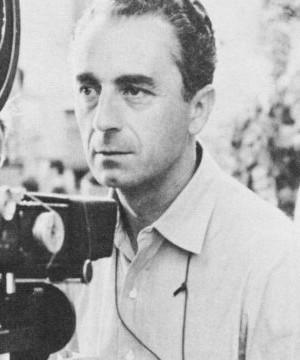After experimenting with 16mm films, writing film criticism for a local newspaper, and working for a bank, he went to rome in 1939 to pursue cinema seriously. There he contributed articles to Cinema, the official film magazine of the Fascist party. In 1940 he briefly attended the Centro Sperimentale di Cinematografia, the famous Italian film school.
He made his first real contact with film production at 30, collaborating on the scripts of Rossellini's Una Pilota Ritorna and Fulchignoni's I Due Foscari (both 1942), also working as assistant director on the latter film. That same year he went to France to assist Marcel Carné as the Italian representative of the French-Italian co-production Les Visiteurs du Soir. He began directing his first film, Gente del Po, a short documentary about Po River fishermen, in 1943 but could not complete it until 1947.
Antonioni then collaborated on the screenplay of De Santis's Caccia Tragica (1947). During the next three years he directed six short documentaries. In 1950, at 38, he finally directed his first feature film, Cronaca di un Amore / Story of a Love Affair, largely unnoticed, though it contained many elements that would crystallize into his highly individualistic and acclaimed style. During the next ten formative years, he directed four films—I Vinti / The Vanquished, La Signora senza Camelie / Camille Without Camelias, Le Amiche / The Girl Friends, and Il Grido / The Outcry—and also collaborated on the script of Fellini's The White Sheik (1952) and directed the "Tentato Suicidio" episode for the film Amore in Città / Love in the City. In 1960 he scored his first international triumph, L'Avventura, which marked the coming to maturity of his unique aesthetic and of his theme and camera style. The dominant theme of L'Avventura, of the next two units in Antonioni's so-called trilogy (La Notte / The Night and Eclisse / Eclipse), and of the subsequent Deserto Rocco / The Red Desert (1964), is the emotional barrennessof modern man—his futile search to assert himself in a technological world and his frustrating inability to communicate with others. Long, lingering shots follow his characters until their inner selves are revealed. By their leisurely immobility the shots suggest the overbearing pressure that time exerts upon human emotions. The surrounding physical world is also used to convey a state of mind and to express the strains of alienation and psychological agony. Antonioni's films are almost plotless, their narrative vagueness almost bordering on mystery. Interest centers on the female, with the male functioning as catalyst.
L'Avventura also marks the first appearance of Monica Vitti as an Antonioni antiheroine. She helped extend the appeal of his films to a wider audience and also seems to have stimulated the element of sensuality that appeared in the director's later films.
Antonioni's skill in manipulating time and space to express the metaphysical world of his characters found a new outlet with his first colour film, Red Desert, in which he even had natural surroundings painted to serve the film's mood and psychological scheme. His next film, Blow-Up (1966), marked a considerable break with the past: it was set in England, used English dialogue, focused on a male protagonist, and proceeded at a brisk, jittery pace. But the element of mystery and ambiguity was still there, and relationships between characters were still tentative and enigmatic.
Antonioni's next film, Zabriskie Point (1970), was set in the American West. Then, after a long absence, Antonioni returned to his style of the 60s and to his preoccupation with the frustration and malaise of modern society with the international co-production Professione: Reporter / The Passenger (1975). Following a setback with The Oberwald Mystery, an undistinguished attempt, marred by experimentation with video techniques, to resurrect Cocteau's The Eagle Has Two Heads, Antonioni returned to more familiar ground with Identification of a Woman (1982). But his reputation rests mainly on his films of the early 60s, truly original works by one of the most remarkable creative artists of the postwar cinema.
— Ephraim Katz, The Film Encylopedia
LINKS
 L'Avventura: review by Roger Ebert
L'Avventura: review by Roger Ebert
 Internet Movie Database
Internet Movie Database
 Michelangelo Antonioni
Michelangelo Antonioni
 The Red Desert: Basement Films Archive review
The Red Desert: Basement Films Archive review
This page has been visited  times since 26 November 1999.
times since 26 November 1999.
